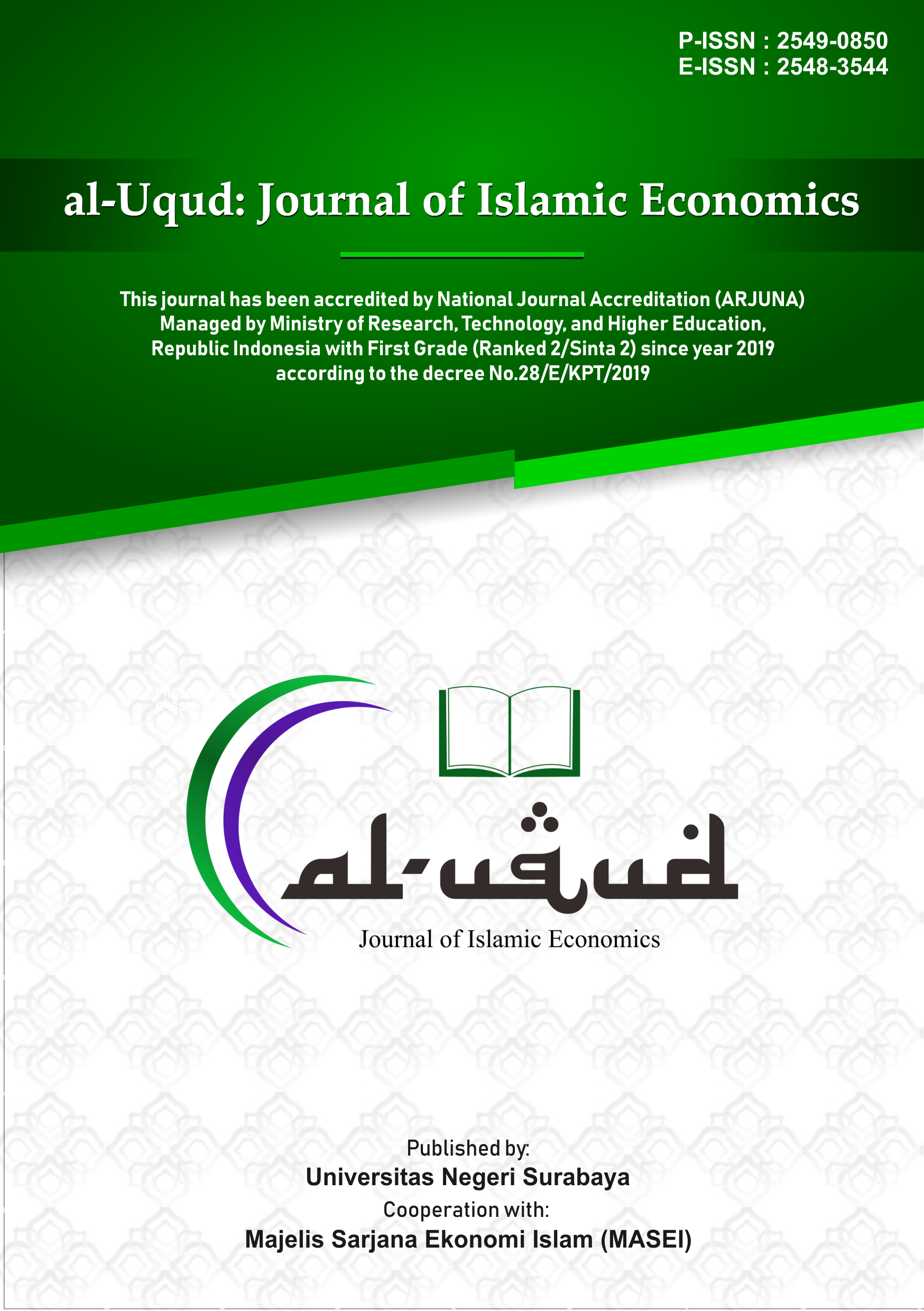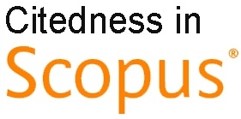Determinants of Customer Preference to Save in Islamic Bank
DOI:
https://doi.org/10.26740/al-uqud.v4n1.p1-17Keywords:
Customer knowledge, Demographic factors, Financial literacy, Profit-sharing, Saving decision, Islamic bankAbstract
The widespread use of sharia products and instruments encourages society to save funds in sharia banks. The main purpose of this research is to test the effect of financial literacy, profit sharing, knowledge of customers, gender, age, education, income to saving decisions. The type of research is quantitative research by using a non-probability sampling method with snowball sampling and purposive sampling technique to get a sample of 230 respondents. The object of this research was sharia bank's customers in Surabaya. The data obtained by spreading the questionnaire online and offline contains 41 items of statement and question. The data analysis technique is multiple linear regression that calculated by software package used for the analysis of statistical data. The result found that financial literacys of customer has medium effect about 72.1% to their saving decision. The higher level of customers financial literacy increases their ability to manage finance and saving. Meanwhile, profit-sharing has an effect to saving decision, as the higher level of profit sharing will raise societys interest for saving in sharia bank. Otherwise, customer knowledge and demographic factors (gender, age, education and income) have no effect to their saving decision.
References
Ajzen, I. (1991). Theory of Planned Behavior. Journal Organizational Behavior and Human Decision Processes, 50(2), 179211. https://doi.org/10.1016/0749-5978(91)90020-t
Ajzen, I., & Fishbein, M. (1977). Attitude-Behaviour Relations: A Theoretical Analysis and Review of Empirical Research. Psychological Bulletin, 84(5), 888918. https://doi.org/10.1037/0033-2909.84.5.888
Babiarz, P., & Robb, C. A. (2014). Financial Literacy and Emergency Saving. Journal of Family and Economic Issues, 35(1), 4050. https://doi.org/10.1007/s10834-013-9369-9
Beckmann, E. (2013). Financial Literacy and Household Savings in Romania. Numeracy, 6(2), 122. https://doi.org/10.5038/1936-4660.6.2.9
BPS (Statistics of Jawa Timur Province). (2018). Jawa Timur Province in Figures 2018. Surabaya. https://jatim.bps.go.id/publication/2018/08/16/9999b727d316c006ee2fd7e7/provinsi-jawa-timur-dalam-angka-2018.html
Chen, H., & Volpe, R. P. (1998). An Analysis of Personal Financial Literacy Among College Students. Financial Services Review, 7(2), 107128. https://doi.org/10.1016/s1057-0810(99)80006-7
Chua, N. E. A., Kiong, S. K. L., Villa, K. H. M., & Paguta, R. B. (2016). A Tobit Analysis of the Determinants and Potentials of Savings in the Case of Payatas Households. Information Management and Business Review, 8(3), 4757. https://doi.org/10.22610/imbr.v8i3.1331
Endalew, B. (2019). Determinants of Households Saving Capacity and Bank Account Holding Experience in Ethiopia: The Case of Dessie Zuria Woreda. Journal of Economics and Sustainable Development, 10(5), 116. https://doi.org/10.7176/JESD
Fry, T. R. L., Mihajilo, S., Russell, R., & Brooks, R. (2008). The Factors Influencing Saving in a Matched Savings Program: Goals, Knowledge of Payment Instruments, and Other Behavior. Journal of Family and Economic Issues, 29(2), 234250. https://doi.org/10.1007/s10834-008-9106-y
Gaisina, S., & Kaidarova, L. (2017). Financial Literacy of Rural Population as a Determinant of Saving Behavior in Kazakhstan. Rural Sustainability Research, 38(333), 3242. https://doi.org/10.1515/plua-2017-0010
Ianole, R. (2014). An Empirical Exploration of Mental Representations in the Individual Saving Decision Process. International Journal of Applied Behavioral Economics, 3(3), 4863. https://doi.org/10.4018/ijabe.2014070104
Indriastuti, H., & Anwar, A. (2018). Effect of Sharia Product Attributes and Insaniyyah Promotion that is Conducted By Sharia Bank Toward Non-Muslims Decision to Become a Customer. In The 2018 International Conference of Organizational Innovation Volume 2018, KnE Social Sciences (Vol. 3, pp. 10671075). https://doi.org/10.18502/kss.v3i10.3449
Kowhakul, M. (2016). Personal Factors Affecting to the Saving Behavior of People in Bangkok Metropolitan Region, Thailand. In 25th International Academic Conference, OECD Headquarters, Paris (pp. 277287). https://doi.org/10.20472/iac.2016.025.036
LPS (Indonesia Deposit Insurance Corporation). (2019). Deposit Statistics of Commercial Banks for 2018. Jakarta. https://lps.go.id/data-distribusi-simpanan/-/asset_publisher/eN56/content/distribusi-simpanan-bank-umum-periode-november-2018
Mariyono, J. (2013). Determinants of Customers in Selecting Sharia Banking System for Saving in East Java - Indonesia. Journal of Economics, Business, and Accountancy | Ventura, 16(3), 457472. https://doi.org/10.14414/jebav.v16i3.225
Modigliani, F., & Brumberg, R. (1954). Utility Analysis and the Consumption Function: An Interpretation of Cross-Section Data. New Brunswick: Rutgers University Press. https://doi.org/10.7551/mitpress/1923.003.0004
Nguyen, T. A. N., Rózsa, Z., Belás, J., & Belásová, Ľ. (2017). The Effects of Perceived and Actual Financial Knowledge on Regular Personal Savings: Case of Vietnam. Journal of International Studies, 10(2), 278291. https://doi.org/10.14254/2071-8330.2017/10-2/19
OJK (Financial Services Authority). (2018). Sharia Banking Statistic August 2018. Jakarta. https://ojk.go.id/id/kanal/syariah/data-dan-statistik/statistik-perbankan syariah/Pages/Statistik-Perbankan-Syariah---Agustus-2018.aspx
Perbawa, A. (2015). Factors Affecting Mudaraba Deposits on Islamic Commercial Bank in Indonesia. SSRN Electronic Journal, 118. https://doi.org/10.2139/ssrn.2662912
Rahmawati, D., & Asandimitra, N. (2018). The Influence of Demography, Social Environment and Financial Self-Efficacy toward Saving Behavior. In Advances in Social Science, Education and Humanities Research, Volume 222 2nd Social Sciences, Humanities, and Education Conference (SoSHEC 2018) (Vol. 222, pp. 102106). https://doi.org/10.2991/soshec-18.2018.22
Rengarajan, V., Sankararaman, G., Kalyana Sundaram, M., Mohamed Rizwan, M., & Mathew Paul Nibin, S. (2016). Influence of Demographic Variables on Saving Behaviour of Rural Households - A Study with Reference to Sriperumpudur, Chennai. Indian Journal of Science and Technology, 9(31), 17. https://doi.org/10.17485/ijst/2016/v9i31/97606
Reswari, A. D., Sudarto, & Widiastuti, E. (2018). The Influence Of Financial Literacy Towards Financial Behavior. Journal of Research in Management, 1(2), 1117. https://doi.org/10.32424/jorim.v1i2.28
Schiffman, L. G., & Kanuk, L. L. (2004). Consumen Behavior (8th ed.). United State of America: Pearson Education International.
Thayeb, N. A. (2019). The Effect of Service and Profit Sharing on the Interests of Non-Musl im Customer to be Customer of Sharia Bank (Case Study At BRI Syariah KC (Branch Office) Manado). Tasharruf: Journal Economics and Business of Islam, 3(2). https://doi.org/10.30984/tjebi.v3i2.787
Ubaidi, A. (2017). Factors Determine the Decision to Become a Customer in a Sharia Bank. Management and Business Review, 1(1), 16. https://doi.org/10.21067/mbr.v1i1.2129
Xiao, J. J. (2008). Applying Behavior Theories to Financial Behavior. In Handbook of Consumer Finance Research (pp. 6981). Verlag New York: Springer. https://doi.org/10.1007/978-0-387-75734-6_5
Yahaya, R., Zainol, Z., Osman, J. H., Abidin, Z., & Ismail, R. (2019). The Effect of Financial Knowledge and Financial Attitudes on Financial Behavior among University Students. International Journal of Academic Research in Business and Social Sciences, 9(8), 1324. https://doi.org/10.6007/IJARBSS/v9-i8/6205
Downloads
Published
How to Cite
Issue
Section
License
CC BY 4.0 Abstract views: 2192
,
Abstract views: 2192
, PDF Downloads: 1244
PDF Downloads: 1244








